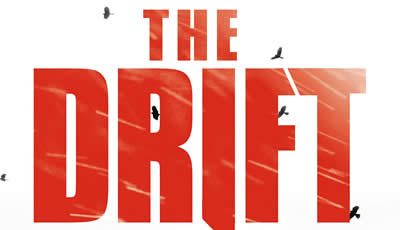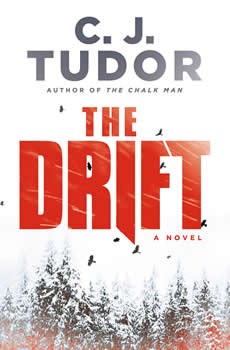

International International Thrills: C.J. Tudor
A Chilling End-of-the-World Survival Story
 By Dawn Ius
By Dawn Ius
Since her award-winning debut, The Chalk Man, C.J. Tudor has been racking up accolades, including praise from most of the thriller genre’s masters—and an often-repeated comparison to Stephen King.
Some may sag under the weight of that tremendous pressure, but Tudor continues to churn out the hits with books that not only thrill her growing fan base but also attract Hollywood attention—all of her six novels have been optioned for TV or film, with The Burning Girls set to hit screens in autumn.
While the rest are “in development,” Tudor is hopeful there will be progress on her latest option—her sixth and newest release THE DRIFT is in the hands of the same team as The Burning Girls.
The tone, however, will be much different. THE DRIFT takes Tudor in a decidedly different direction than her previous books, weaving together three stories of survival in a post-apocalyptic world into one chilling novel. Hannah, Meg, and Ryan face near-insurmountable odds and extreme danger as we trudge to the terrifying core of the novel.
THE DRIFT may not be traditional Tudor—but her exceptional writing is familiar, and it does the job of luring you in and keeping you there until the chilling finale.
In this interview with The Big Thrill, Tudor shares how the story evolved, the impact the pandemic had on her writing it, and a little about what she’s working on next.
I’d love to hear more about the inspiration for THE DRIFT and how you navigated the shift from more classic thriller to this gripping end-of-the-world survival story.
I had the idea for THE DRIFT back in 2019. I was thinking about locked-room mysteries and wondering what was the most impossible locked-room mystery you could write? The idea of a stranded cable car came to mind. But that wasn’t really enough for a whole novel, so I thought, how about three locked-room mysteries somehow connected? A stranded cable car, an overturned coach, and an isolated chalet. Three groups of people trapped by a snowstorm with a killer lurking within each one. But it still needed something more. How did these groups of people come to be trapped, and why was no rescue coming? What else was going on in this world? For various reasons, I couldn’t write THE DRIFT in 2019. And then the pandemic happened. In a way, that was the final piece of the puzzle, and THE DRIFT became something much more than just a snowbound murder mystery.
Given your success, would you consider it a risky move, or “the right time,” or something you even considered at all?
I never really think of it like that. Once you start worrying about other people’s expectations, it stymies creativity and stops you writing from the heart. I write what I love and what excites me. Writing the same book over and over holds no interest. I want a fresh playground each time. Obviously, Mr. King is a hero, and I love how he can write something as tight and claustrophobic as Misery and something as expansive as The Stand. I never want to be restricted creatively.
We’re introduced to three main characters, each grappling with something terrifying in the wake of “something” that has happened—Hannah is trapped in a coach with a few survivors after careening over a hillside; former detective Meg is in a cable car suspended over a snowstorm with no memory of how she got there; and Carter finds himself trapped with a few friends in an abandoned ski chalet with a waning generator. They’re all terrifying scenarios, even without the “big bad” looming in the background. Which of these characters was the most complicated to write and why?
Hmmm. They all presented challenges. Meg’s was tricky because of the very claustrophobic setting. Keeping story momentum going in that tight situation can be a challenge. Hannah’s was technically difficult because of working out the angle of the coach and mechanics of escape. And Carter’s was tricky for “other” reasons!
Each of the three characters has very separate storylines, and I couldn’t stop reading because I had to know how they all connected. Obviously, we can’t talk about that here, but in terms of process, was this a book that required intricate plotting? Did you work on separate storylines and then merge them? It seems like it might be a challenge from a structural perspective.
I wrote each character’s storyline separately and then I wove them all together. I actually wrote the book in reverse too, so I had the ending in place before anything else. Editing it all together was fun! Like an intricate piece of construction. I think we had three proofreaders on it eventually because it was so complex.
I don’t think it’s a spoiler to say that the dystopian landscape in THE DRIFT was created by a viral outbreak. How much influence did living through the past few years of the COVID-19 pandemic have on your writing, and in what ways?
Well, I had already been thinking about a viral backdrop and then the pandemic happened (which made me feel weirdly prophetic). But actually, I don’t think I would have been able to give the book such depth if we hadn’t lived through the pandemic. It enabled me to examine how humanity functions under stress. Obviously, it was also a risk. Although the virus is a background to the story and not the main focus, I worried that it might be too soon. Fortunately, I think we’ve had time to get some distance and reflect on that period. In a way, THE DRIFT is a dark vision of what could have happened in a parallel world.
In addition to the virus, THE DRIFT challenges our protagonists with a number of dangers—wild animals, the Whistlers… Aside from a compelling read, which it is, what do you hope readers take away from this harrowing story of survival?
Hope . . . in a weird way! I enjoy writing characters who aren’t necessarily nice or even good but are relatable. I hope it makes people wonder how they would react if pushed to the very limit. What would you do to survive, and would your humanity remain intact? As one character observes—”Survival is a solitary business.”
At the time of this interview, the city where I live was at -54F. Cold. That is something your characters face in THE DRIFT, and I thought you effectively captured that “chill.” Was that based on personal experience, or what other tools did you use to create that setting?
Well, the UK can get pretty cold too! I found it easy to imagine the freezing cold and the difficulties it presented, even though I wrote a lot of THE DRIFT during a heatwave in the summer.

After two cancelled trips to Disneyland due to COVID-19, Tudor and her family were finally able to make their Disneyworld dream holiday a reality this past October.
Given the topics covered in THE DRIFT, I suspect research was involved. What was the most surprising thing you learned?
I learned quite a lot about the workings of coach toilets! Very glamorous. I also did a lot of research on cable cars and on the science of vaccines and blood plasma. However, there is a fair degree of creative license too. Generally, my rule of thumb with research is to learn enough to make something feasible even if it isn’t always wildly probable. It’s usually the mundane stuff you need to pay most attention to. Not many people will ever have to escape a cable car. But most of us have travelled by coach. So the details need to be accurate, or someone will call you on it.
Prior to being able to write full-time, you’ve had careers as a copywriter, TV presenter, voiceover artist, and dog walker. How have those jobs prepared you for life as a novelist? Do you miss dog walking? I feel like that’s the career I would miss the most.
I did enjoy being a dog walker—I loved all the dogs I walked—but it was hard work for not very much money! Everyone thinks it’s a nice job in the summer. Not so much when you’re traipsing around in the mud and pouring rain in winter. It was good for plotting, though. I still enjoy getting out with our dog and unknotting tricky plot issues. Copywriting was also a good skill because it taught me to edit. To cut what isn’t necessary.
What can you tell us about what you’re working on next?
Ooooh, well I’m very excited about Book 7. It’s set in Alaska. There’s a gruesome murder, a plucky female cop, hostile townsfolk . . . and vampires! I described it to my editor as “30 Days of Night meets Fargo.” See what I mean about not wanting to write the same book twice?
- The Ballad of the Great Value Boys by Ken Harris - February 15, 2025
- Don’t Look Down by Matthew Becker - February 15, 2025
- The Wolf Tree by Laura McCluskey - February 14, 2025



